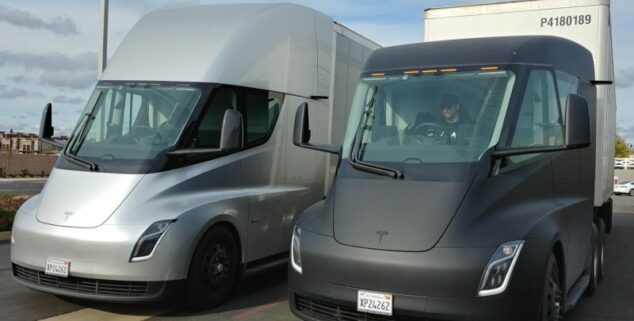News
From diesel big rigs to electricity: The costly transition begins
 A pair of all-electric big-rig trucks, built by Tesla, are ready for the road. (Photo: Steve Jurvetson, via Wikipedia)
A pair of all-electric big-rig trucks, built by Tesla, are ready for the road. (Photo: Steve Jurvetson, via Wikipedia)Never mind there are few on the market, or that keeping them moving requires a nonexistent network of chargers, California wants truckers to hurry up and replace diesel big rigs with versions that run on batteries or hydrogen.
Regulations to achieve the transitions are not yet complete. The California Air Resources Board is gathering public opinion on the latest iteration and a subsequent draft is anticipated in the spring.
Few expect many changes in response to previous rounds of public comment. When the rule-making is complete, the final plan is likely to look much as it does now.
While it remains very much a developing market, electric big rigs can be bought.
In its current form, the Advanced Clean Fleets regulations would phase in zero-emission requirements starting in 2035, the same year California will put an end to the sale of new cars with combustion engines.
Then, over the following decade, a series of benchmarks would be met, culminating in 2045 when, according to plan, California will have shifted its commercial transport sector to emission-free power.
It is by any measure an ambitious goal. But California has set and met ambitious goals before, particularly in cleaner air. Currently, there are about 15 million private and commercial trucks registered in California, an overall figure that includes big-rigs and other trucks.
While it remains very much a developing market, electric big rigs can be bought. And trucking companies will save money in the long run, tens of billions of dollars. That’s the state perspective.
Trucking companies, however, see a plan in which the pace is too fast, the subsidies too low and the exemptions too few.
Or, in the gray language of government summary: “While zero-emission vehicles are expected to cost more up front today … as components and battery prices fall and technology continues to improve, total cost of ownership is expected to become more favorable.”
As for concerns about the lack of charging infrastructure, the state will pour seed money on a nascent network. And, at any rate, for the first step – short-distance hauling near ports and distribution centers – trucking companies can maintain their own chargers for these close-in, closed-loop trips.
Trucking companies, however, see a plan in which the pace is too fast, the subsidies too low and the exemptions too few. They say the state has unrealistic expectations for the expansion of a charging network and for potential cost savings.
For now, there are no savings, only costs. And truckers see those costs stacking up, much as the state sees them diminishing.
The transition, especially at the pace envisioned, will cause “staggering losses in the efficiency of the state supply chain.” — Chris Shimoda
Truckers won’t be able to carry as much, since some of their weight capacity will be consumed by battery storage. And they won’t be able to log miles fast enough, since they will spend hours waiting for a charge, something they could accomplish in minutes with fuel. And that’s assuming they can find the industrial-grade chargers they need.
The transition, especially at the pace envisioned, will cause “staggering losses in the efficiency of the state supply chain,” said Chris Shimoda, senior vice president of the California Trucking Association.
Trucking companies are struggling with an aging workforce and a next generation that seems less interested in the uncertainty of a career for which robots appear to be waiting in the wings.
“There are already difficulties,” Shimoda said.
But climate change isn’t going away and regulators are tasked with making the state’s policy, as articulated by the Air Resources Board, a reality.
The decades-long phased-in – which CARB describes as a smooth transition to ZEV fleets – features the following key benchmarks.
- 100 percent zero-emission drayage trucks, last mile delivery, and government fleets by 2035
- 100 percent zero-emission refuse trucks and local buses by 2040
- 100 percent zero-emission capable utility fleets by 2040
Where the plan relies on emerging technology, it offers an exemption. If the needed product is not available, keep using what works. Fleets could continue to buy internal combustion trucks when no reasonable emissions-free alternative exists.
None of it is cheap. A current-technology diesel big-rig tractor costs from $120,000 to $150,000. A battery-powered replacement is about $350,000 t0 $450,000.
“It’s an order of magnitude more expensive,” Shimoda said.
Among the first beneficiaries of a shift to cleaner transport will be those who live near ports and alongside freight corridors, where lower housing costs come with heightened exposure to harmful pollutants.
“Neighborhoods located near seaports, railyards, warehouses, and distribution centers are disproportionately affected by high truck traffic from medium- and heavy-duty trucks,” according to CARB’s summary documents.
In just over 10 years, the first significant benchmark, trucks entering ports and railyards will not belch diesel. According to plan, they will be clean.
“This,” says CARB, “will greatly reduce the harmful impacts of tailpipe emissions and disruptive noise in California communities.”
Want to see more stories like this? Sign up for The Roundup, the free daily newsletter about California politics from the editors of Capitol Weekly. Stay up to date on the news you need to know.
Sign up below, then look for a confirmation email in your inbox.

Leave a Reply